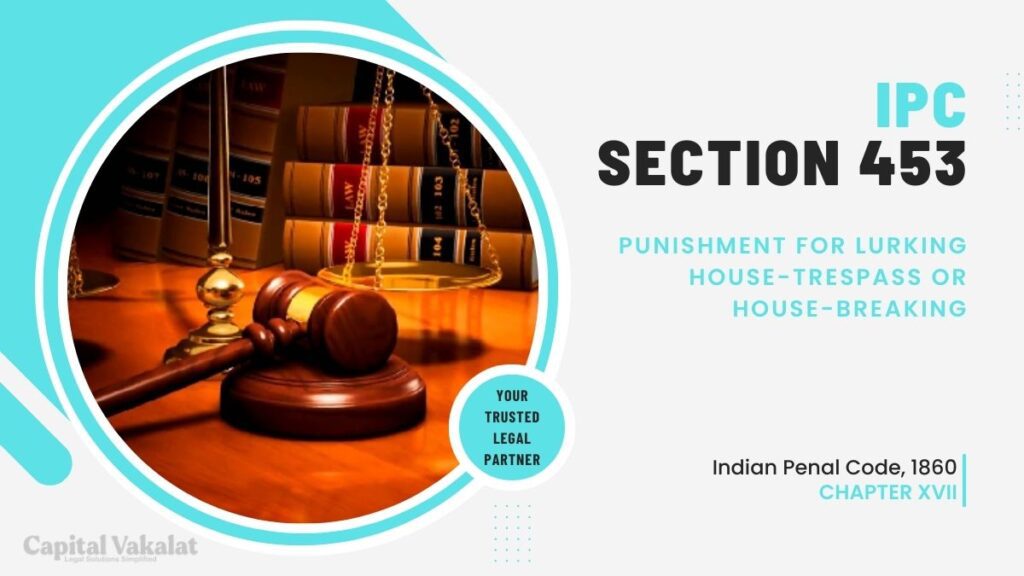In the labyrinth of legal statutes, Section 453 IPC stands as a sentinel guarding the sanctity of homes. As we delve into the depths of this provision, it becomes apparent that it addresses a grave concern – punishment for lurking house-trespass or house-breaking.

This article aims to unravel the complexities surrounding this section, shedding light on its nuances, degrees of punishment, judicial interpretations, and its impact on society.
Understanding Section 453 IPC
Section 453 of the Indian Penal Code is a formidable legal instrument designed to address crimes that infringe upon the inviolability of one’s dwelling. House-trespass and house-breaking, the focal points of this provision, represent distinct but interconnected offenses. It is imperative to grasp the intricacies of the legal language to appreciate the gravity of actions falling under this section.
Elements of Lurking House-Trespass
Lurking house-trespass, a phrase that resonates with clandestine activities, encapsulates a specific set of actions that transgress the boundaries of a residence. The term ‘lurking’ implies a sense of surreptitious intent, where an individual intentionally hovers around a dwelling with dubious motives. Understanding the elements that constitute lurking house-trespass is crucial for a comprehensive grasp of the legal implications.
Elements of House-Breaking
House-breaking, a term that evokes images of unlawful intrusion, encompasses a broader spectrum of actions. It involves not only trespassing into a house but also breaking into it, symbolizing a more forceful and intrusive act. Differentiating the elements of house-breaking from lurking house-trespass is essential for legal clarity and accuracy in the application of Section 453 IPC.
Degrees of Punishment
The severity of punishment meted out under Section 453 IPC varies based on the nature of the offense. While lurking house-trespass may incur a lesser penalty, the gravity of house-breaking warrants more stringent consequences. Understanding the factors that influence the degree of punishment is paramount for both legal practitioners and the general populace.
Judicial Interpretations
Landmark judicial decisions play a pivotal role in shaping the interpretation and application of Section 453 IPC. Examining cases where the section has been invoked provides insights into the evolving legal landscape and the judiciary’s stance on issues related to house-trespass and house-breaking. These interpretations often set precedents that guide future legal proceedings.
Deterrence and Prevention
The punitive measures outlined in Section 453 IPC serve not only as a means of retribution but also as a deterrent. Analyzing the effectiveness of this section in deterring potential offenders and its role in preventing crimes against property helps assess its societal impact. Heightened public awareness of the legal consequences acts as a deterrent, contributing to the overall security of homes.
Reform and Amendments
In a dynamic legal environment, statutes undergo revisions to address emerging challenges. Exploring recent changes or amendments to Section 453 IPC unveils efforts to align the law with contemporary issues. Evaluating the effectiveness of these reforms is essential for ensuring the continued relevance and efficacy of the legal framework.
Impact on Society
The enforcement of Section 453 IPC extends beyond individual cases, influencing societal dynamics. Understanding the implications of effective enforcement on community safety, property values, and public trust in the legal system provides a holistic perspective. A proactive approach to combating house-trespass and house-breaking contributes to the overall well-being of society.
Conclusion
In conclusion, Section 453 IPC serves as a bulwark against the violation of one’s abode, prescribing punishment for lurking house-trespass or house-breaking. Through an exploration of its elements, degrees of punishment, judicial interpretations, and societal impact, we gain a profound understanding of the significance of this legal provision. A robust legal framework is indispensable in safeguarding the sanctity of homes and fostering a secure living environment for all.
Frequently Asked Questions
What factors influence the degree of punishment under Section 453 IPC?
The nature of the offense, severity of intrusion, and any aggravating or mitigating circumstances can influence the degree of punishment.
How does Section 453 IPC contribute to crime prevention?
The section acts as a deterrent by outlining punishments, raising public awareness, and fostering a sense of security within communities.
Have there been recent amendments to Section 453 IPC?
It is recommended to check the latest legal updates, as amendments may occur to address evolving challenges.
What role do judicial interpretations play in shaping Section 453 IPC?
Landmark cases and judicial interpretations set precedents, guiding the application and understanding of the section in legal proceedings.